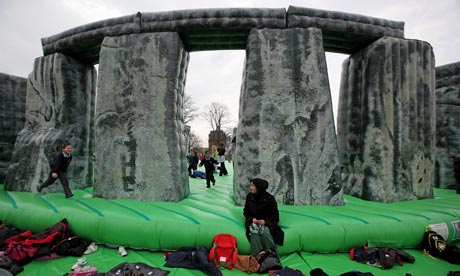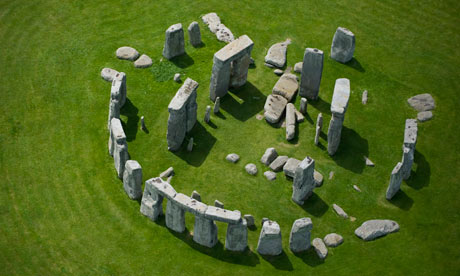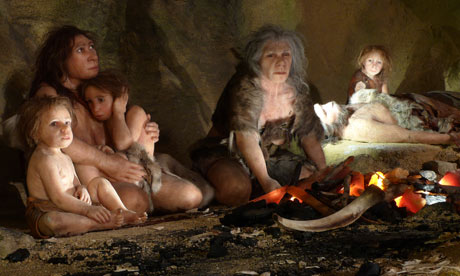The Prehistoric Archaeology Blog is concerned with news reports featuring Prehistoric period archaeology. If you wish to see news reports for general European archaeology, please go to The Archaeology of Europe Weblog.
Monday, April 30, 2012
Stone me! Archaeologists' new theory on ancient north Pembrokeshire site
Human Genes Provide Clues to Rise and Spread of Agriculture in Prehistoric Europe
Friday, April 27, 2012
Ancient DNA sheds light on spread of European farming
The genetic profiles of three Neolithic hunter-gatherers and one farmer who lived in the same region of modern-day Sweden about 5,000 years ago were quite different — a fact that could help resolve a decades-old battle among archaeologists over the origins of European agriculture, said study leader Mattias Jakobsson, a population geneticist at Uppsala University in Sweden.
The hunter-gatherers, from the island of Gotland, bore a distinct genetic resemblance to people alive today in Europe's extreme north, said Jakobsson, who reported his findings in Friday's edition of the journal Science. The farmer, excavated from a large stone burial structure in the mainland parish of Gokhem, about 250 miles away, had DNA more like that of modern people in southern Europe.
read the rest of this article
Wednesday, April 25, 2012
Jeremy Deller's inflatable Stonehenge gives Glasgow a bounce in its step

Where's the Beef? Early Humans Took It
X-ray may reveal Bronze Age secrets
Tuesday, April 24, 2012
Did climate change shape human evolution?
Dartmoor Bronze Age burial remains X-rayed in Salisbury

Are We Sliding Backward on Teaching Evolution?
Monday, April 23, 2012
Pre-historic remains to be x-rayed at Salisbury Hospital
Meat Eating Behind Evolutionary Success of Humankind, Global Population Spread, Study Suggests
How Humans Became Masters of the Earth
Sunday, April 22, 2012
Neolithic farmers brought deer to Ireland
Comparing DNA
Saturday, April 21, 2012
Salford scientists reveal the 'sound of Stonehenge'

Swedish Stonehenge? Ancient Stone Structure Spurs Debate

|
|
An ancient megalithic structure shaped like a ship in
Sweden seems to have a similar geometry to Stonehenge, and may have been
used as an astronomical calendar, one scientist says. CREDIT: Steffen Hoejager | Shutterstock |
Archaeologists uncover graves of national significance near Meigle
Ancient graves unearthed in Strathmore
 |
| Graves uncovered by the Meigle dig.[Credit: Courier] |
Despite the increase in the identification of these sites through aerial photography surveys since the 1970s, they are still generally rare and so are of immense significance.
Experts say the Meigle project represents the first complete excavation of a barrow cemetery to date, providing a unique opportunity to comprehensively analyse the monument.
Thursday, April 19, 2012
One of earliest farming sites in Europe discovered
 |
| UC students Kassi Bailey (yellow shirt), Michael Crusham (blue shirt), and Kathleen Forste (red shirt) at work on the excavation [Credit: Image courtesy of University of Cincinnati] |
"For Albania, there has been a significant gap in documenting the Early Neolithic (EN), the earliest phase of farming in the region," explains Allen. "While several EN sites were excavated in Albania in the '70s and '80s, plant and animal remains - the keys to exploring early farming - were not recovered from the sites, and sites were not dated with the use of radiocarbon techniques," Allen says.
Wednesday, April 18, 2012
Penlee Museum shows Bronze Age necklace Penwith lunula

How I traced my ancestry back to the Stone Age
Favourite science writing: Sleeping with Neanderthals

Kolbert so skillfully manages the tricky task of weaving several concurrent stories through the one feature, that the reader is hardly aware of the jumps in a long piece that flows without crossheads or text-breakouts. Through it, she includes a profile of palaeogeneticist Svante Pääbo, the unfolding genetic and developmental story of human evolution, and the creation of fast-throughput genetic analysis, all infused within the central philosophical and scientific question of what it means to be human. Why are we so special? What enabled us to take over the world while our cousins are caged in zoos or extinct?
Ancient walking gets weirder
Tuesday, April 17, 2012
Ancient burial urns uncovered at St Albans King Harry Park site
Monday, April 16, 2012
Standards needed to record the mark of our ancestors

A standard approach
More on ancient burial urns found at St Albans
 |
| CT scan image of the contents of one of the five urns [Credit: BMI Bath Clinic] |
One of the conditions of approval for the Linden Homes development was that archaeologists could investigate the site before it was built upon.
Friday, April 13, 2012
Slideshow: Roman and Iron Age finds at college
Roman remains have been discovered at an archaeological dig at a Cambridge theological college which is planning a £9 million extension.
A major project to update and create state-of-the-art teaching and living space at Ridley Hall meant archaeologists were drafted in to carry out a survey.
After removing the topsoil the experts from Access Cambridge Archaeology discovered the “tantalising possibilities” of a Roman settlement, and even some remains dating back 3,000 years to the Iron Age.
Read the rest of the article...
Maritime Cornwall opens 2012 BC: Cornwall and the Sea in the Bronze Age exhibition
A single bronze disc decorated with gold symbols that represent the sun, moon, stars and a boat, the Nebra Sky Disc is the world's oldest representation of the cosmos.
It reveals a prehistoric view of the world that before its discovery had never been known to exist, and has single-handedly reformed our understanding of ancient European history.
Greece reopens Bronze Age site on Santorini island
Known as the "Pompeii of the Aegean", the prehistoric town was buried under thick layers of volcanic ash during an eruption 3,700 years ago that may have destroyed the Minoan civilisation in Crete to the south.
"One of the most significant archaeological sites in Greece and the world opened its gates again," said Deputy Culture and Tourism Minister Petros Alivizatos. "Akrotiri, which is now fully safe, will attract visitors and boost Greek tourism."
The site was closed down in 2005 after its roof collapsed killing a 45-year old Welsh tourist. A new roof made of steel and wood now shelters the settlement discovered by Greek archaeologists in 1967.
Wednesday, April 11, 2012
Prehistoric buildings found on Skomer Island
A team of archaeologists have found "hidden" remains of prehistoric buildings and fields on Skomer Island, off the Pembrokeshire coast.
 |
| Archaeologists carried out a geophysical survey of the island to find out what's beneath the surface [Credit: BBC] |
Dr Toby Driver from the Royal Commission on the Ancient and Historical Monuments of Wales said they may date back 5,000 years.
Read the rest of the article...
Tuesday, April 3, 2012
Playing with Fire
For many years it was believed that humans didn’t use fire until about 800,000 years ago. But two College of Arts & Sciences archaeologists have found evidence in South Africa of a man-made fire dating back 1.2 million years, the earliest such discovery. The finding by Francesco Berna and Paul Goldberg substantially pushes back the date that humans laid the first kindling. Berna and Goldberg’s research was published yesterday in the online edition of Proceedings of the National Academy of Sciences.
Knowing when man first made fire has huge implications for understanding how our species evolved. Once early man had flames at his command, he not only had a source of heat, but a means to cook food. By unlocking nutrients in food, cooking made for a much better diet that not only boosted overall health, but may have contributed to other modern human traits, such as increased brain size and pair bonding, as the prominent primatologist Richard Wrangham has argued. Berna and Goldberg’s discovery bolsters Wrangham’s theory that our evolutionary predecessor, Homo erectus, was building fires and cooking far sooner than was previously thought.
Read the rest of the article...


